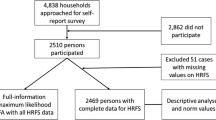Abstract
Health messages framed to be congruent with individuals’ approach/avoidance motivations have been found to be more effective in promoting health behaviors than health messages incongruent with approach/avoidance motivations. This study examines the processes underlying this congruency effect. Participants (undergraduate students, N=67) completed a measure of approach/avoidance orientation (the BIS/BAS scales) and read either a gain- or loss-framed message promoting dental flossing. Results demonstrated a congruency effect: Participants who read a congruently framed message had greater flossing efficacy, intended to floss more, and used more dental flosses than did the participants who read an incongruent message. Moreover, intention to perform the behavior predicted the congruency effect and self-efficacy mediated participants’ intentions to perform the health behavior. Discussion centers on the role of personality factors and situational factors in models of behavior change.


Similar content being viewed by others
Notes
Prior to reading the health article, participants first completed a computer-based anagram-solving task. There was a manipulation embedded in the anagram task. Half of the participants were given one ticket for every anagram they got correct (up to 10), and half of the participants were given 10 tickets, and one was taken away for every anagram they got incorrect. The manipulation did not affect flossing behavior or intentions and will not be mentioned further.
We tested our interaction hypothesis using two-way ANOVA and a categorical, rather than continuous, operationalization of motivational orientation. As our main dependent measure (flossing) showed substantial deviation from normality, ANOVA allows for a more robust test of the hypotheses as compared to moderated multiple regression. However, to ensure that our results were not simply an artifact of analytical procedure, we replicated the interaction by recoding the flossing measure into three roughly equal categories, and used ordered logit regression with a continuous (BIS minus BAS) rather than categorical measure of motivational orientation (interaction coefficient=−1.92, SE=.88, Z=−2.17, p=.03).
In all steps of the mediational analyses, the main effects of message frame and motivational orientation were included, but are not reported for the sake of brevity.
References
Ajzen, I. (1991). The theory of planned behavior. Organizational Behavior and Human Decision Processes, 50, 179–211.
Bandura (1998). Health promotion from the perspective of social cognitive theory. Psychology and Health, 13, 623–649.
Baron, R. M. & Kenny, D. A. (1986). The moderator-mediator variable distinction in social psychological research: Conceptual, strategic, and statistical considerations. Journal of Personality and Social Psychology, 51, 1173–1182.
Carver, C. S., Sutton, S. K., & Scheier, M. F. (2000). Action, emotion, and personality: Emerging conceptual integration. Personality and Social Psychology Bulletin, 26, 741–751.
Carver, C. S., & White, T. L. (1994). Behavioral inhibition, behavioral activation, and affective responses to impending reward and punishment: The BIS/BAS scales. Journal of Personality and Social Psychology, 67, 319–333.
Derryberry, D., & Reed, M. A. (1994). Temperament and attention: Orienting toward and away from positive and negative signals. Journal of Personality and Social Psychology, 66, 1128–1139.
Elliot, A. J., & McGregor, H. A. (2001). A 2 x 2 achievement goal framework. Journal of Personality and Social Psychology, 80, 501–519.
Gray, J. A., (1990). Brain systems that mediate both emotion and cognition. Cognition and Emotion, 4, 269–288.
Mann, T., Sherman, D., & Updegraff, J. (2004). Dispositional motivations and message framing: A test of the congruency hypothesis in college students. Health Psychology, 23, 330–334.
Petty, R. E., & Wegener, D. T. (1998). Matching versus mismatching attitude functions: Implications for scrutiny of persuasive messages. Personality and Social Psychology Bulletin, 24, 227–240.
Rothman, A. J., & Salovey, P. (1997). Shaping perceptions to motivate healthy behavior: The role of message framing. Psychological Bulletin, 121, 3–19.
Sobel, M. E. (1982). Asymptotic confidence intervals for indirect effects in structural equation models. In S. Leinhart (Ed.), Sociological Methodology 1982 (pp. 290–312). San Francisco: Jossey-Bass.
Steward, W. T., Schneider, T. R., Pizarro, J., & Salovey, P. (2004). Need for cognition moderates responses to framed smoking cessation messages. Journal of Applied Social Psychology, 19, 407–423.
Tversky, A., & Kahneman, D. (1981). The framing of decisions and the psychology of choice. Science, 211, 453–458.
Updegraff, J. A., Sherman, D. K., Luyster, F. S., & Mann, T. (in press). The effects of message quality and congruency on perceptions of tailored health communications. Journal of Experimental Social Psychology.
Williams-Piehota, P., Pizarro, J., Schneider, T. R., Mowad, L., & Salovey, P. (2005). Matching health messages to monitor-blunter coping styles to motivate screening mammography. Health Psychology, 24, 58–67.
Acknowledgments
This research was supported in part by a Council on Research Academic Senate Grant to the second author. We thank Shelly Gable, Curtis Hardin, Heejung Kim, David Pizarro, Matt Rohlfes, and Shelley Taylor for their helpful comments on an earlier version of this paper, and the following individuals for their assistance with this study: Melissa Dunagan, Annie Kwan, Jen Mato, Dee Michelbock, Dani Pallafacchina, and Anna Park. Finally, we acknowledge Benjamin and Jonah Engelmann and Jacob and Isabelle Kim-Sherman for their continuing cheerful presence. This study was reported at the American Psychological Association Annual Convention, 2002.
Author information
Authors and Affiliations
Corresponding author
Additional information
This research was supported in part by a Council on Research Academic Senate Grant to the second author.
Rights and permissions
About this article
Cite this article
Sherman, D.K., Mann, T. & Updegraff, J.A. Approach/avoidance motivation, message framing, and health behavior: understanding the congruency effect. Motiv Emot 30, 164–168 (2006). https://doi.org/10.1007/s11031-006-9001-5
Received:
Accepted:
Published:
Issue Date:
DOI: https://doi.org/10.1007/s11031-006-9001-5




